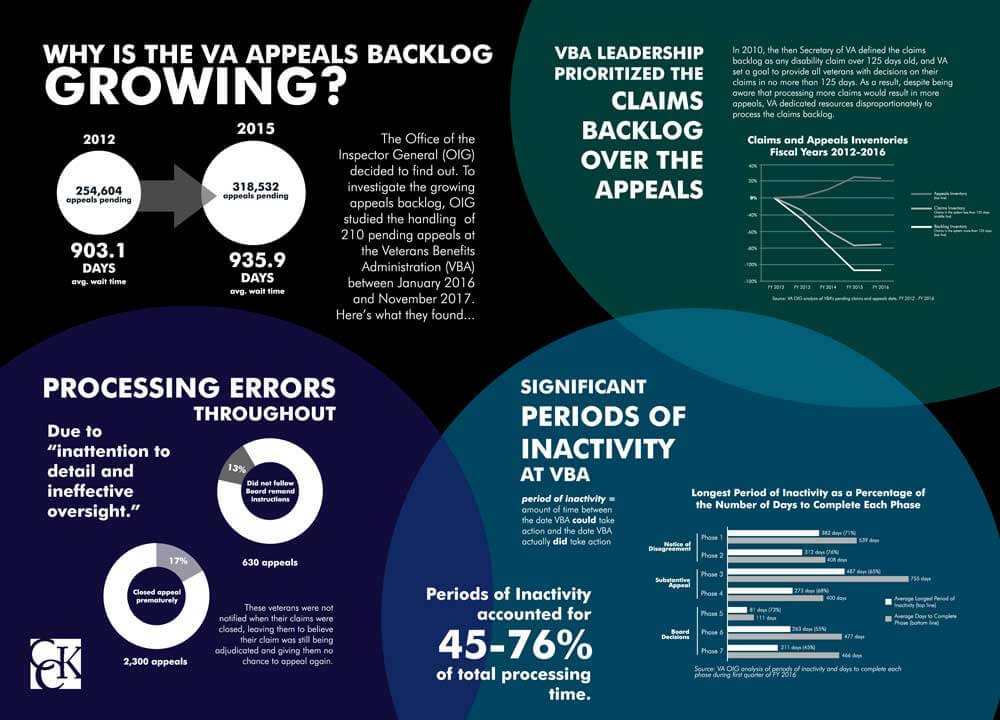The VA Appeals Backlog is Still Growing: Here’s Why

CCK Law: Our Vital Role in Veterans Law
March 29, 2018 – The VA Office of Inspector General (OIG) released an almost 50-page report detailing the timeliness, or lack thereof, of appeals at the Veterans Benefits Administration (VBA).
The OIG conducted the report to determine if opportunities existed for VBA staff to improve the timeliness of the appeals process following numbers released by the VBA in 2012 showing that a pending appeal takes an average of 903.1 days to resolve, and 935.9 days to resolve in 2015. The increase in the average time to resolve an appeal is due to an increase in the amount of appeals pending at the VBA. In 2012, the VBA reported having 254,604 appeals pending, while in 2015 they reported having 318,532.
What the Report Looked At
The OIG report was conducted from January 2016 to November 2017 and used a random sample of 30 appeals related to seven phases of the appeals process handled by the VBA including those surrounding notices of disagreement (NODs), substantive appeals, and implementing Board of Veterans’ Appeals (Board) decisions. The sample size totaled to 210 appeals.
The OIG looked at how much time it took for the VBA staff to complete processing action in each of the stages.
What the OIG Report Found
The report found that the “VBA staff did not always timely process the appeals workload.” The OIG found that the VA took an average of 111 to 755 days to complete the phases, with “significant periods of inactivity throughout all phases.”
The report defines a “period of inactivity” as time when “VBA staff could have taken action on an appeal to when they actually took an action.” They found that “a single period of inactivity accounted for approximately 45 to 76% of the total processing time in each phase.”
Not only did the VBA staff take long periods of time to handle appeals, they also mismanaged appeals which caused further delays. The report found that 17% of all appeals were closed prematurely and about 13% of appeals were not processed in accordance with the Board’s remand instructions.
Why the Delays?
In interviews with VBA officials, the report notes that VBA leadership prioritized the backlog of rating claims over appeals, meaning they focused on deciding initial claims rather than handling the appeals of claims that had been already pending.
The report also acknowledges that the VBA “had an ineffective procedure for notifying [VA rating officers] that they were required to process Board grants,” and the failure to properly complete the Board’s remand instructions were a result of a lack of attention to detail and “ineffective oversight.” The report also notes that appeals were prematurely closed due to a failure to update the VA electronic system, or updating it incorrectly.
Further findings
The report found that VBA staff issued favorable decisions in only 29% of appeal stages completed during the first quarter of fiscal year 2016.
The report approximates that of the roughly 23,200 appeals resolved in the first quarter of fiscal year 2016, about 7% were closed due to the death of the appellant, coming out to about 1,600 appeals. Of the 1,600, about 1,100 had been pending for more than one year before the appellant passed away.
For the approximately 2,300 appeals that were prematurely closed during this period, the report notes that “appellants were likely unaware since [VA staff] did not notify the appellants at the time the VA closed the appeals.” This means that veterans were likely not informed that their appeals were closed by VA staff, leading them to believe that their appeals were still awaiting decisions.
For those appeals remanded from the Board, approximately 630 were returned to the Board without finishing the remand instructions, causing further delay.
How Will This Be Solved?
The OIG report recommended that the Undersecretary for Benefits “increase resources towards meeting its established targets related to processing timeliness,” monitor to ensure Board decisions are addressed in a timely manner, and implement a plan to “amend VBA procedures for closing appeals records to prevent appeals being closed prematurely.”
The OIG report confirms what many veterans already know: the VA takes a long time to issue decisions and resolve appeals. These “legacy appeals” are in the current VA appeals process focused on in the report. However, the Veterans Appeals Improvement and Modernization Act of 2017 aims to decrease the amount of time veterans wait for decisions and also decrease the backlog of “legacy appeals.”
About the Author
Share this Post
